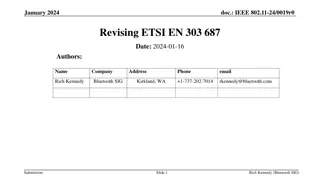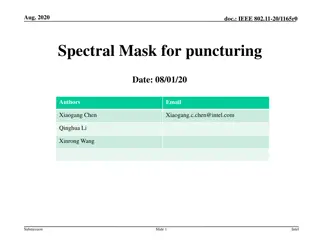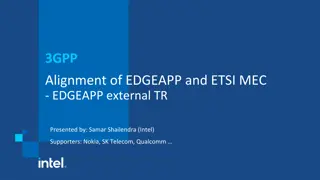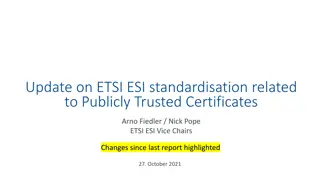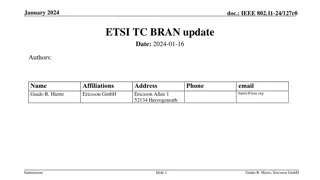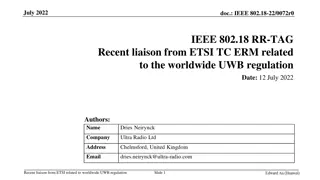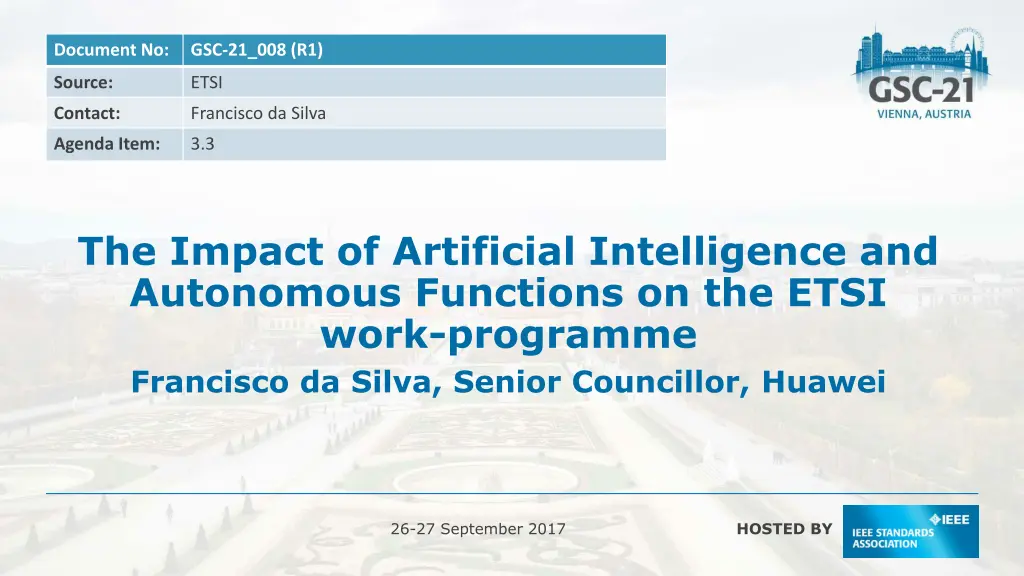
Impact of Artificial Intelligence and Cognitive Technologies on ETSI Work Programme
Discover the significant influence of Artificial Intelligence and Cognitive Technologies on ETSI standards development activities, outlining cognitive technologies as key drivers of technology advancements. Explore ETSI's strategic approach towards cognitive technology while delving into the roadmap for integrating Artificial Intelligence into the technical work programme.
Download Presentation

Please find below an Image/Link to download the presentation.
The content on the website is provided AS IS for your information and personal use only. It may not be sold, licensed, or shared on other websites without obtaining consent from the author. If you encounter any issues during the download, it is possible that the publisher has removed the file from their server.
You are allowed to download the files provided on this website for personal or commercial use, subject to the condition that they are used lawfully. All files are the property of their respective owners.
The content on the website is provided AS IS for your information and personal use only. It may not be sold, licensed, or shared on other websites without obtaining consent from the author.
E N D
Presentation Transcript
Document No: GSC-21_008 (R1) Source: ETSI Contact: Francisco da Silva Agenda Item: 3.3 The Impact of Artificial Intelligence and Autonomous Functions on the ETSI work-programme Francisco da Silva, Senior Councillor, Huawei 26-27 September 2017 HOSTED BY
Cognitive Technologies in the Focus of ETSI ETSI puts focus on cognitive in the context of standards development activities [The] digital transformation of our economies impacts and is influenced by all aspects of life from the way we live, work, care and are cared for, to the way in which we are governed and interact with our governments. Cognitive technologies are considered to be a major driver of technology and application developments Its influence and impact is expected to penetrate ever wider and deeper, driven by and creating a dynamic and evolving world of digital and cognitive technologies and their applications. ETSI's Long Term Strategy sets the framework for looking at cognitive technology across the board in ETSI. Cognitive defined as: a mental action or process of acquiring knowledge and understanding (The Oxford Dictionary) [ETSI Long Term Strategy, p. 6.] 26-27 September 2017 Pg 2 |
ETSI Roadmap on Artificial Intelligence (AI) EDUCATION AND AWARENESS IMPACT ANALYSIS Technical Bodies analyse possible impact of AI for their scope of work Broad education, information and awareness raising around AI in ETSI AI@ ETSI ETSI TECHNOLOGY ROADMAP ACTION PLAN AND IMPLEMENTATION Include AI into ETSI Technology Roadmap Identify and agree on actions Integrate AI into Technical Work Programme => Effective mechanisms for addressing AI issues 26-27 September 2017 Pg 3 |
Artificial Intelligence Impacts in ETSI (1/3) Artificial Intelligence enables the display of behaviour that may be described as intelligent: It may be used to select technologies to be applied in different parts of the network it implies that: Artificial Intelligence is used to recommend or make decisions The Impacts of Artificial intelligence on the ETSI Work- programme are: Radio access technology, AI used in Vehicle Connectivity, IMT2020 including: 4G/5G radio integration / AI adaptive antennas / Shared Spectrum bands Satellite in adaptive tracking and handoff 26-27 September 2017 Pg 4 |
Artificial Intelligence Impacts in ETSI (2/3) Access, x-Haul and Core network technologies, Network Management & Control, including: Network Slicing - Fixed-Mobile Integration Autonomic Management & Control (AMC) Paradigm for networks is specified to use AI, network planning and service introduction, Autonomics may use AI Administration and day-to-day network organization to recommend optimised use of resources Closed loop learning and context-aware policies Virtualization and Orchestration Network routing and optimisation 26-27 September 2017 26-27 September 2017 Pg 5 |
Artificial Intelligence Impacts in ETSI (3/3) Critical communications maintenance Policy and operation AI for Secure Communications AI Techniques to rapidly compute Cryptographic codes Lawful Interception - Analysing Big data to track intercepted content Home Networking (Wireline ,Wireless ,Optical) plans to use AI Gateway applications in their many and possible variants IoT devices will use AI coordination, needing standards for ontologies and big data processing, including standards for quality of data and tracking of data usage for liability etc. 26-27 September 2017 26-27 September 2017 Pg 6 |
AI in Autonomic Functions for the Autonomic Management & Control (AMC) Paradigm ETSI has a project on Generic Autonomic Networking Architecture; Autonomic Functions using the AMC Paradigm. This is currently managed within TC NTECH Working Group AFI. GANA AFs are Autonomic Decision-Making Elements for Network Management & Control that can be instrumented at 4 basic complementary abstraction levels for Self-Management within Network Nodes and in the Outer Management and Control realm Autonomics algorithms include Cognitive algorithms for Artificial Intelligence such as Machine Learning and Deep Learning, and other algorithms that can be employed in Decision-Making Elements (DEs) closed-loop operations 26-27 September 2017 26-27 September 2017 Pg 7 |
The ETSI GANA Architecture Cognitive algorithms for AI Machine Learning (ML) and Deep Learning (DL) Cognitive algorithms for AI Machine Learning (ML) and Deep Learning (DL) Less complex Cognitive algorithms for AI Less complex Cognitive algorithms for AI 26-27 September 2017 26-27 September 2017 Pg 8 |
Administration and day-to-day network organization Optimised use of resources - Closed loop learning & context-aware policies ETSI has a project called:Experiential Networked Intelligence. ENI will specify a set of use cases, and the generic technology independent architecture, for a network supervisory assistant system based on the observe-orient-decide-act control loop model. This model can assist decision-making systems, such as network control and management systems, to adjust services and resources offered based on changes in user needs, environmental conditions and business goals. The ETSI Work on ENI focuses on improving the operator experience, adding closed-loop artificial intelligence mechanisms based on context-aware, metadata-driven policies to more quickly recognize and incorporate new and changed knowledge, and hence, make actionable decisions. 26-27 September 2017 26-27 September 2017 Pg 9 |
The ETSI ENI Goals 26-27 September 2017 26-27 September 2017 Pg 10 |
Thank you For more information, please contact: Francisco da Silva Francisco.daSilva@huawei.com Ray Forbes rayforbes@mail01.huawei.com Affiliation Name: ETSI www.etsi.org 26-27 September 2017



